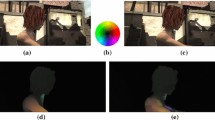Abstract
Many low level visual computation problems such as focus, stereo, optical flow, etc., can be formulated as problems of extracting one or more parameters of a non-stationary transformation between two images. Finite-width windows are widely used in various algorithms to extract spatially local information from images. While the choice of window width has a very profound impact on the quality of algorithmic results, there has been no quantitative way to measure or eliminate the negative effects of finite-width windows. To address this problem and the foreshortening problem caused by non-stationarity, we introduce two novel sets of filters: “moment” filters and “hypergeometric” filters. The recursive properties of these filters allow the effects of finite-width windows and foreshortening to be explicitly analyzed and eliminated.
We apply the moment filter approach to the focus and stereo problems, in which one parameter is extracted at every pixel location. We apply the hypergeometric approach to the optical flow problem, in which two parameters are extracted. We demonstrate that algorithms based on moment filters and hypergeometric filters achieve much higher precision than other state-of-art techniques.
Similar content being viewed by others
References
Abramowitz, M. and Stegun, I.A. 1972. Handbook of Mathematical Functions with Formulas, Graphs, and Mathematical Tables, U.S. Government Printing Office: Washington, DC.
Adelson, E.H. and Bergen, J.R. 1984. Spatiotemporal energy models for the perception of motion. Journal of Optical Society of America, A, 284–299.
Barron, J.L., Fleet, D.J., and Beauchemin, S.S. 1994. System and experiment: Performance of optical flow techniques. International Journal of Computer Vision, 12(1):43–77.
Bove, V.M. Jr., 1989. Discrete fourier transform based depth-from-focus. In Proceedings OSA Topical Meeting on Image Understanding and Machine Vision.
Bovik, A.C., Clark, M., and Geisler, W.S. 1990. Multichannel texture analysis using localized spatial filters. IEEE Trans. Patt. Recog. Machine Intell., 12(1):55–73.
Fleet, D.J. and Jepson, A.D. 1989. Computation of normal velocity from local phase information. In Proc. Comput. Vision Patt. Recog., pp. 379–386.
Fleet, D.J. and Jepson, A.D. 1991. Stability of phase information. In Proc. of IEEE Workshop on Visual Motion, Princeton, New Jersey, pp. 52–60.
Fleet, D.J., Jepson, A.D., and Jenkin, M. 1991. Phase-based disparity measurement. CVGIP: Image Understanding, 53(2):198–210.
Gabor, D. 1946. Theory of communication. Journal of the IEE, 93:429–457.
Heeger, D.J. 1988. Optical flow using spatiotemporal filters. International Journal of Computer Vision, 279–302.
Jain, A.K. and Farrokhnia, F. 1991. Unsupervised texture segmentation using Gabor filters. Pattern Recognition, 24(12):1167– 1186.
Jones, D.G. and Malik, J. 1992. A computational framework for determining stereo correspondence from a set of linear spatial filters. In European Conference on Computer Vision, pp. 395–410
Kanade, T. and Okutomi, M. 1990. Astereo matching algorithm with an adaptive window: Theory and experiment. In DARPA Image Understanding Workshop, pp. 383–398.
Krumm, J. and Shafer, S.A. 1992. Shape from periodic texture using the spectrogram. In Proc. Computer Vision Patt. Recog., pp. 284– 289.
Krumm, J. and Shafer, S.A. 1993. Segmenting textureed 3D surfaces using the space/frequency representation. Technical Report CMU-RI-TR-93-14, The Robotics Institute, Carnegie Mellon University.
Langley, K., Atherton, T.J., Wilson, R.G., and Larcombe, M.H.E. 1990. Vertical and horizontal disparities from phase. In European Conference on Computer Vision, pp. 315–325.
Malik, J. and Rosenholtz, R. 1993. A differential method for computing local shape-from-texture for planar and curved surfaces. In Proc. Computer Vision Patt. Recog., pp. 267–273.
Nardin, M., Perger, W.F., and Bhalla, A. 1992a. Algorithm 707 CONHYP: A numerical evaluator of the confluent hypergeometric function for complex arguments of large magnitudes. ACM Transactions on Mathematical Software, 18(3):345–349.
Nardin, M., Perger, W.F., and Bhalla, A. 1992b. Numerical evaluation of the confluent hypergeometric function for complex arguments of large magnitudes. Journal of Computational and Applied Mathematics, 39:193–200.
Nikiforov, A.F. and Uvarov, V.B. 1988. Special Functions of Mathematical Physics. Birkhauser Verlag Basel.
Pentland, A.P. 1987. A new sense for depth of field. IEEE Transactions on PAMI, 9(4):523–531.
Press, W.H., Flannery, B.P., Teukolsky, S.A., and Vetterling, W.T. 1988. Numerical Recipes in C. Cambridge University Press.
Sanger, T.D. 1988. Stereo disparity computation using Gabor filters. Biological Cybernetics, 59:405–418.
Smith, R.C. and Cheeseman, P. 1986. On the representation and estimation of spatial uncertainty. The International Journal of Robotics Research, 5(4).
Spanier, J. and Oldham, K.B. 1987. An Atlas of Functions. Washington: Hemisphere Pub. Corp.
Subbarao, M. 1988. Parallel depth recovery by changing camera parameters. In 2nd International Conference on Computer Vision, pp. 149–155.
Weng, J. 1990. A theory of image matching. In International Conference on Computer Vision, pp. 200–209.
Willson, R.G. and Shafer, S.A. 1992. Precision imaging and control for machine vision research at carnegie mellon university. Technical Report CMU-CS-92-118, School of Computer Science, Carnegie Mellon University.
Xiong, Y. and Shafer, S.A. 1993. Depth from focusing and defocusing. In Proc. Computer Vision Patt. Recog., pp. 68–73.
Xiong, Y. and Shafer, S.A. 1994. Moment and hypergeometric filters for high precision computation of focus, stereo, and optical flow. Technical Report CMU-RI-TR-94-28, The Robotics Institute, Carnegie Mellon University.
Xiong, Y. and Shafer, S.A. 1994. Variable window Gabor filters and their use in focus and correspondence. In Proc. Computer Vision and Pattern Recognition, pp. 668–671.
Xiong, Y. and Shafer, S.A. 1995. Hypergeometric filters for optical flow and affine matching. In International Conference on Computer Vision, pp. 771–776.
Author information
Authors and Affiliations
Rights and permissions
About this article
Cite this article
Xiong, Y., Shafer, S.A. Moment and Hypergeometric Filters for High Precision Computation of Focus, Stereo and Optical Flow. International Journal of Computer Vision 22, 25–59 (1997). https://doi.org/10.1023/A:1007927810205
Issue Date:
DOI: https://doi.org/10.1023/A:1007927810205




